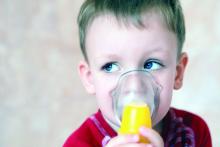Children with asthma who present to emergency departments for treatment are significantly more likely to test positive for one or more respiratory pathogens, reported Dr. Joanna Merckx of the Montreal Children’s Hospital at the McGill University Health Centre, and her associates.
Nearly two-thirds of patients tested positive for one or more respiratory viruses in a study conducted by Dr. Merckx and her associates. “Given the documented safety of influenza immunization in children with asthma and its expected protective effect,” such cases should be among those prioritized to receive influenza immunization.
Dr. Merckx and her associates conducted an ancillary multicenter, prospective, ethics-approved cohort study to identify a possible connection between diagnosed respiratory pathogens, severity of illness, and the overall risk of ED treatment failure using data from the DOORWAY (Determinants of Oral Corticosteroid Responsiveness in Wheezing Asthmatic Youth) study .In reviewing the findings of the study, Dr. Merckx and her colleagues sought to determine whether closely evaluating the effects of specific respiratory pathogens could be useful in further developing appropriate preventive treatments for children with asthma; improving efforts to diagnose pathogens at the time of ED treatment; and identifying patients at higher risk of treatment failure who could be candidates for more intensive treatment protocols.
Children aged 1-17 years presenting to one of five EDs in the Pediatric Emergency Research Canada network during 2011-2013 with moderate or severe asthma flares were considered for the study. All eligible DOORWAY study participants with a valid respiratory specimen were included in the study and received a standardized dose of oral and bronchodilator treatment with salbutamol; those with severe exacerbations also received ipratropium bromide ( Atrovent).
Within 1 hour of study inclusion, patients were tested by way of nasopharyngeal aspirate or swab. Patients identified with coinfection presented with two or more pathogens. Failure of ED management was defined as patients admitted to the hospital for asthma; ED treatment lasting 8 or more hours after corticosteroid treatment; or returns to the ED within 72 hours after discharge that led to hospital admission or prolonged ED stay.
Of 1,012 children enrolled in the study, 958 were assessed for worsening of asthma symptoms. Of the 958 respiratory specimens tested, 62% tested positive for one or more pathogens, 8.5% were found to have coinfection, of which respiratory syncytial virus (RSV) and coronavirus were the most frequent copathogens. Rhinovirus was the most prevalent pathogen, occurring in 29%, and of these, rhinovirus C was the most frequent species (18.2%), followed by RSV (17.9%); only two patients tested positive for Mycoplasma pneumoniae .
Children with a laboratory-confirmed pathogen were younger, had higher tobacco exposure, and were slightly more likely to present with fever (29% vs. 24%), compared with children without a laboratory-confirmed pathogen. Children with rhinovirus were less often febrile (16% vs 41%) and less frequently diagnosed with pneumonia (5% vs. 16%.) than those without a rhinovirus infection The proportion of children presenting with a severe exacerbation of asthma was 33%.
Overall, 17% of patients experienced treatment failure. Those with current respiratory infection were at increased risk of treatment failure, for a risk difference of 8% (95% confidence interval, 3.3%-13.1%). RSV, influenza, and parainfluenza virus (PIV) were associated with 21%, 38%, and 47% higher risks of treatment failure, respectively, noted Dr. Merckx and her associates. These resulted in absolute risks of 9%, 25%, and 34%, respectively, the authors reported in Pediatrics.
Coronavirus, adenovirus, enterovirus D68, and the presence of a coinfection, however, were not found to increase the risk of treatment failure, they noted.
Although rhinovirus may play a role in triggering reactions that require medical attention, such cases still appear to respond favorably to treatment, they said.
A separate study cited by Dr. Merckx and her associates observed the same outcome for rhinovirus patients but more patients diagnosed with nonrhinovirus pathogens, especially human metapneumovirus (hMPV) and PIV, had moderate, rather than severe, symptoms and were much more likely to experience higher treatment failure, particularly those infected with RSV, influenza, and PIV.
“It appears reasonable to pursue strategies to improve immunization coverage for influenza and invest in efforts for the development of vaccines for RSV and rhinovirus,” they said.
In cases in which respiratory pathogens were present (especially nonrhinovirus pathogens), greater treatment failure occurred, despite use of inhaler and corticosteroids. The researchers noted that severity of condition at time of treatment and patient response to treatment should be considered as two separate, distinct dimensions of viral infection impact in children with acute asthma. “The high prevalence of rhinovirus C in children presenting with asthma exacerbation, its presumed association with asthma-related hospitalization, and its peak in the fall,” also should be considered as a leading cause for more potential severe disease.
Dr. Merckx and her associates did point to several possibly significant implications with their findings. Intensifying treatment using inhaled anticholinergics or magnesium sulfate could block the vagally mediated reflex bronchoconstriction typically seen in cases of asthma exacerbation worsened by viral infection. Although these therapies currently only are used only in severe reactions, it may be useful to examine their efficacy in any cases triggered by RSV, influenza, and PIV because these have been associated with a poor treatment response.
While it still is necessary to clarify its mechanism of action, azithromycin’s demonstrated benefit in preschoolers with severe reactions suggests it could be a possible alternative pathogen–nonspecific therapy to address antineutrophilic inflammation, they said.
Any treatment intensification would first require clear identification of responsible pathogens using on-site diagnostic measures in the ED. Until such testing is possible, preventive measures need to be prioritized, they advised.
Dr. Merckx had no relevant disclosures; two of her associates reported receiving grants, salary rewards, and/or unrestricted donations from various pharmaceutical companies or foundations.
SOURCE: Merckx J et al. Pediatrics. 2018 Jun;142(1):e20174105 .

